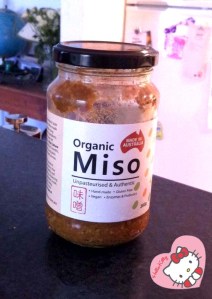Couple of weeks ago I found this new stall at our organic farmers markets in Miami – Rice Culture,
They sell Organic Miso – fermented product made from soy beans,
There only 4 items in the Ingredients on the label : Australian organic soy beans , Australian organic rice, sea salt and culture (Koji starter), I like when things in the jars have only a few ingredients on the the list and when they all sound like natural ones 🙂 Yay! Well this miso is not only Unpasteurized and Organic, it is also hand made and it’s made locally, here on the Gold Coast.

I realize the photo would look better if the jar was full, unfortunately i already finished half of it :))
It turns out that Miso is quite an ancient food, ” Miso’s origins can be traced to China as far back as the 4th century BC. A seasoning, called Hisio, was a paste resulting from the fermenting a mixture of soybeans, wheat and salt. In Japan, miso was introduced in the 7th century by buddhist monks. The process of making Miso was furher refined and it became a necessary part of the samurai diet. ”
Miso is a paste that can be used in various ways in cooking, it’s a base for traditional Japanese Miso soup, you can add it in vegetables when you cook or make a sauce with it. I even like using it as a spread on toast ! I just checked Rice Culture website and they have some interesting recipes there – Rice Culture
I like Miso because of it’s taste and it’s grounding effect on my system, especially if it’s cold or windy outside, of after I spent the whole day running around , it really helps to settle down. Miso is also quite good for you because it ‘s a product of natural fermentation process – ” Miso’s fermentation process enables the superior nutritional characteristics of the soybean to be assimilated readily by the body. Miso is a rich source of proteins, fibre, minerals, vitamines and isoflavones, (about 20mg/100g), saponins, soy protein (partly digested) and live enzymes (in non-pasteurized miso).”
Live enzymes – that sounds interesting ….There is a whole concept how fermentation process transforms the nutrients in the grains and soy beans making them more readily available for our system to utilize. They say that is the reason why all ancient breads were made with a cultured starter (I started making rye bread with a home made starter, I ll make a separate post about it)
I searched online looking for more information on the benefits of fermented soy products, another concept I came across (I heard about it before as well) is this one – ” All legumes contain phytate (also known as phytic acid) to some extent, but the soybean is particularly rich in this anti-nutrient. Phytate works in the gastrointestinal tract to tightly bind minerals such as zinc, copper, iron, magnesium and calcium, causing the deficiency. In most legumes soaking is enough to break down most of the phytate content. However the soybean requires that the enzymes be released in the fermentation process to reduce its phytate content to the point where it becomes fit for consumption. This means that fermented soy foods like miso and tempeh have the lowest levels of phytate and are the best choices for anyone wishing to eat soybean products. Tofu is also a good choice, as long as care is taken to replenish loss nutrients” (Source – Natural News). That’s something new for me… Oh well, with soy products, like with any other “health foods” there will be the whole bunch of opinions stating how it’s so good for you, it fights cancer, etc and the whole bunch of opposite opinions stating that it slows down brain function …
I guess the key is in moderation. I remember I read once in one book on Ayurvedic cooking, how Western mentality can perceive something as only good or only bad, like yogurt is very good for you or yogurt is terribly bad for you. According to Ayurveda if you eat a little bit of yogurt (which is actually a cultured food too) with the right spices it’s good, if you eat too much or late at night it becomes a heavy food. “When fermented soy foods are used in small amounts they help build the inner ecosystem, providing a wealth of friendly microflora to the intestinal tract that can help with digestion and assimilation of nutrients, and boost immunity”.
How to use Miso
-Miso is a sticky paste and it needs to be mixed with a bit of water if you want to use it in a soup or in a sauce .
-To preserve the good bacteria in Miso it should never be cooked with the food but added at the end of the cooking.
-After opening a package of Miso it will keep for several months in the fridge.
And now it’s time for me to go and eat a toast with some Miso paste on top 😉
